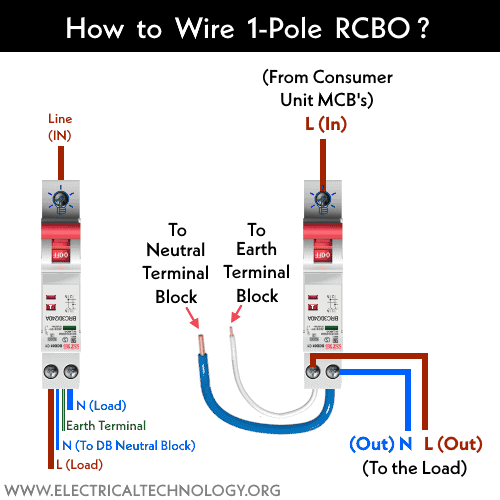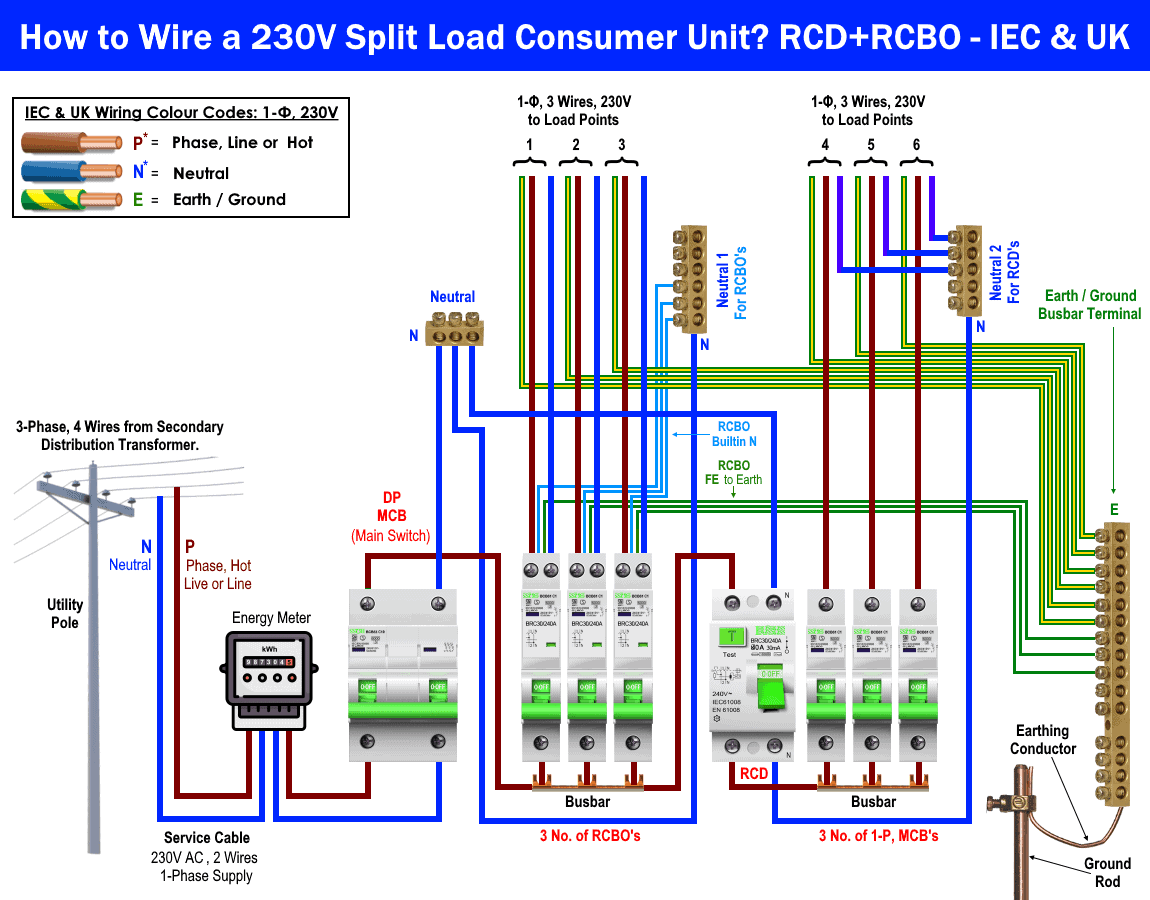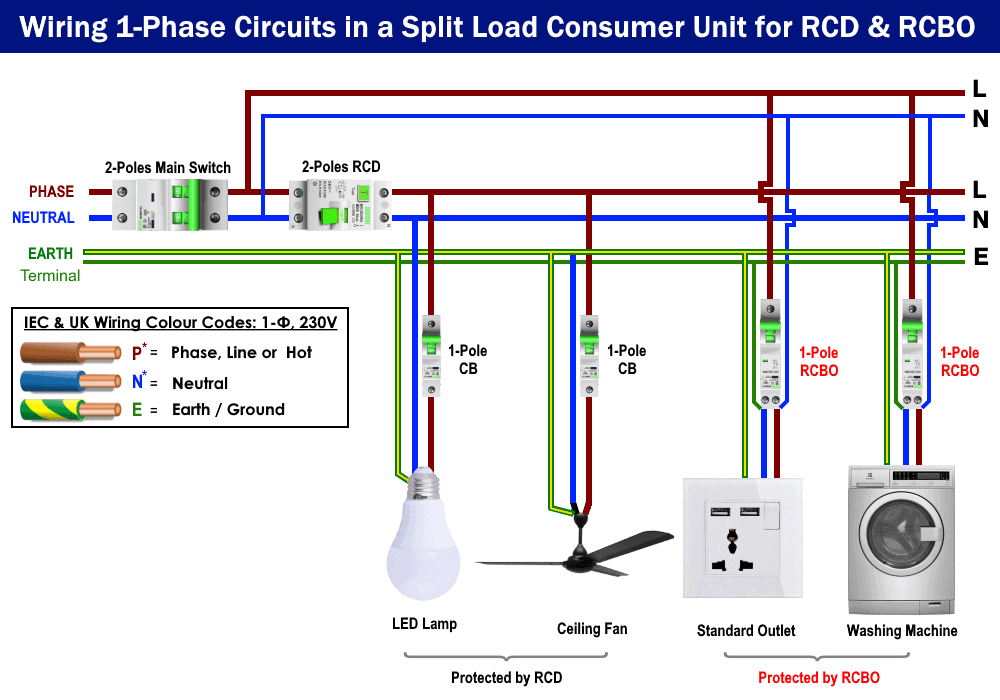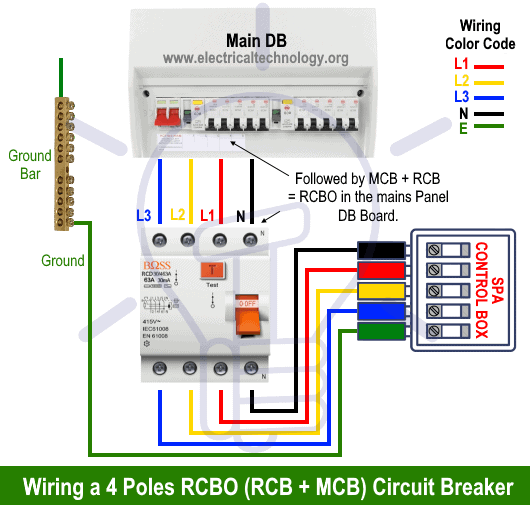How to Wire an RCBO? Residual Current Breaker with Overcurrent
Wiring a 1P, 2P & 3P RCBOs – Residual Current Breaker with Overcurrent Protection
A Residual Current Breaker with Overcurrent Protection (RCBO) is a protective device that safeguards electric circuits and appliances from both short circuits/overcurrents and leakage/earth faults. It incorporates features of both Miniature Circuit Breakers (MCBs) and Residual Current Devices (RCDs or RCCBs). In today’s post, we will show how to wire 2-P, 3-P and 4-P RCBOs for different load circuits.
The RCCB unit senses current imbalances in both the phase and neutral wires, detecting leakage faults, while the MCB unit protects against short circuits and overcurrents.
Related Post: How to Wire 1-Phase Split Load Consumer Unit? – RCD+RCBO
Why to Use RCBO instead of MCB or RCD?
Using an RCBO is a suitable option instead of an RCD or MCB. In the case of a leakage or earth fault, the RCD will trip and disconnect all circuits connected to it until the fault issue has been resolved. In contrast, the RCBO will only interrupt the dedicated circuit connected to it, allowing the rest of the circuits to work reliably and smoothly.
In addition, it is a wise decision to use, when applicable, a single unit of RCBO that offers the functions of both RCD and MCB in a single device. This is particularly beneficial when space in the consumer unit / DB is limited for additional or existing breakers
In the following wiring tutorial, we will demonstrate how to wire single-pole, two-pole, and four-pole RCBOs in distribution boards and consumer units for both single-phase 230V and three-phase 415V AC supplies.
How to Wire 1-Phase, 1-Pole RCBO?
The following diagram shows the wiring connection of a 1-pole RCBO for single-phase, 230V AC – (1P + N) load points.
As shown, the two built-in wires (blue and white) should be connected to the main neutral terminal block and earth terminal block in the consumer unit or distribution board. The Line terminal (1) should be connected to the line wire from the main MCB. The lower terminals of L and N should be connected to the single-phase load points, such as socket outlets.
Single Pole RCBOs in Consumer Units and DBs
The following wiring diagram illustrates a split-load consumer unit where some load points are protected by RCBOs, while the rest are protected by RCDs and MCBs.
Click image or open in new tab to enlarge
Similarly, the next wiring diagram shows that the washing machine and standard outlet are connected and protected by RCBOs, while the LED lamp and ceiling fan are connected and protected by an MCB and an RCD.
Click image or open in new tab to enlarge
How to Wire 1-Phase, 2-Pole RCBO?
The two-pole RCBO can be wired the same way as a generic 2-pole MCB or an RCD. As shown in the figure, the 230V single-phase supply from the main MCB or RCD in the consumer unit/distribution board is connected to the input terminal of the RCBO via the Line and Neutral wires.
Similarly, the output terminals of the RCBO are connected to the load point, such as a standard socket, via outgoing Line and Neutral wires.
How to Wire 3-Phase, 4-Pole RCBO?
The following wiring diagram shows the Three-Phase Four-Pole RCBO (3P + N) used to protect a hot water spa.
As illustrated in the wiring diagram, the three-phase lines (L1, L2, and L3) from the consumer unit MCBs are connected to the upper terminals of the 4-pole RCBO. The neutral wire must also be connected to the “N” input terminal.
Similarly, all three-phase (hot or live) wires, along with the neutral wires, are connected to the three-phase 415V AC spa control box. Finally, the ground wire is connected to the load terminal box.
For 3-phase spa wiring, use #10 or a minimum of #12 gauge for each line conductor. For instance, use 4.0mm2 (#12 gauge) for each phase wire for loads up to 12kW, with a 3-phase 415VAC configuration. In the case of higher wattage, refer to the table in the manual for the appropriate wire size.
Related Premium Wiring Tutorials Resources:
- How to Wire a Garage Consumer Unit?
- Wiring of the Distribution Board with RCD
- Wiring of the Distribution Board without RCD
- Single Phase Electrical Wiring Installation in Home – NEC & IEC
- Three Phase Electrical Wiring Installation in Home – NEC & IEC
- How to Wire a Three Phase, 400V Distribution Board? IEC & UK
- How to Wire Combo of 3 & 1-Φ, 400V/230V Distribution Board?
- How to Wire a UK 3-Pin Plug? Wiring a BS1363 Plug
- How to Wire a UK 3-Pin Socket Outlet? Wiring a BS1363 Socket
- How to Wire a Twin 3-Pin Socket Outlet? Wiring 2-Gang Socket
- How to Wire a GFCI Circuit Breaker?
- How to Wire an AFCI Breaker?
- How to Wire and Install an Electrical Outlet Receptacle?
- How to Size a Load Center, Panelboards and Distribution Board?
- How to Determine the Number of Circuit Breakers in a Panel Board?
- How to Determine the Right Size Capacity of a Subpanel?











